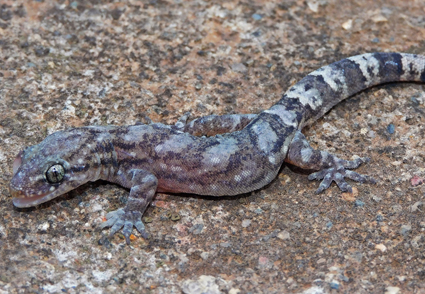Abstract
We formally name the distinct population of Dravidogecko in Coonoor Hills of the Upper Nilgiris, Western Ghats, India. The initial attempt that demonstrated molecular and geographical divergence of this species, unfortunately fell short on Code compliance for nomenclatural availability. We here sampled the very same population from the same location as that by the previous authors who erected an unavailable name. Following its published critic, we here erect the nomen Dravidogecko coonoor sp. nov. for this species, along with the first typification and full-fledged specimen description.
References
- Anonymous [International Commission on Zoological Nomenclature] (1999) International Code of Zoological Nomenclature. Fourth edition. London (International Trust for Zoological Nomenclature): i–xxix + 1–306.
- Adhikari, O. D., Srikanthan, A. N. & Ganesh, S. R. (2023) A new species of Dravidogecko (Squamata: Gekkonidae) from the under-surveyed Periyar Plateau of the southern Western Ghats in Peninsular India. European Journal of Taxonomy, 870: 146–166. <https://doi.org/10.5852/ejt.2023.870.2125>.
- Agarwal, I., Bauer, A. M., Pal, S., Srikanthan, A. N. & Khandekar, A. (2020) Two more new Hemiphyllodactylus Bleeker, 1860 (Squamata: Gekkonidae) from Tamil Nadu, India. Zootaxa, 4729 (2): 249–265. <https://doi.org/10.11646/zootaxa.4729.2.6>.
- Bansal, R. & Karanth, K. P. (2013) Phylogenetic analysis and molecular dating suggest that Hemidactylus anamallensis is not a member of the Hemidactylus radiation and has an ancient late Cretaceous origin. PLoS One, 8 (5) [e60615]: 1–8. <https://doi.org/10.1371/journal.pone.0060615>.
- Beddome R. H. (1888) Lizards, snakes & frogs. In: H. B. Grigg (ed.), A manual of the Nílagiri District in the Madras Presidency, Madras (Government Press): 171–176.
- Chaitanya, R. (2022) Another new, unavailable nomen (Squamata, Gekkonidae) from Indian herpetological taxonomy. Bionomina, 26 (1): 59–61.
- Chaitanya, R., Giri, V. B., Deepak, V., Datta-Roy, A., Murthy, B. H. C. K. & Karanth, P. (2019) Diversification in the mountains: a generic reappraisal of the Western Ghats endemic gecko genus Dravidogecko Smith, 1933 (Squamata: Gekkonidae) with descriptions of six new species. Zootaxa, 4688 (1): 1–56. <https://doi.org/10.11646/zootaxa.4688.1.1>.
- Dubois, A. (2000) Synonymies and related lists in zoology: general proposals, with examples in herpetology. Dumerilia, 4: 33–98.
- Dubois, A. (2008) Phylogenetic hypotheses, taxa and nomina in zoology. Zootaxa, 1950 (1): 51–86. <https://doi.org/10.11646/zootaxa.1950.1.7>.
- Günther, A. C. L. G. (1875) Second report on collections of Indian reptiles obtained by the British Museum. Proceedings of the zoological Society of London, 43 (1): 224–234.
- Jerdon, T. C. (1854) Catalogue of the Reptiles inhabiting the Peninsula of India. Part 1. Journal of the Asiatic Society of Bengal, 22: 462–479.
- McDiarmid, R. W., Foster, M. S., Guyer, C., Chernoff, N., & Gibbons, J. W. (ed.) (2012) Reptile biodiversity: standard methods for inventory and monitoring. Berkeley (University of California Press): 1–452. <https://doi.org/10.1525/9780520952072>.
- Menegon, M. (2007) Methods for surveying and processing reptiles and amphibians of Alpine springs. The spring habitat: biota and sampling methods. Trento (Museo Tridentino di Scienze Naturali): 275–285.
- Roux, J. (1928) Reptiles et Amphibiens de l’Inde méridionale. Revue suisse de Zoologie, 35 : 439–472. <https://doi.org/10.5962/bhl.part.117624>.
- Satish, K. V., Pasha, S. V. & Reddy, C. S. (2024) Spatial conservation prioritization of landscapes in Nilgiri Biosphere Reserve, Western Ghats. In: Biodiversity hotspot of the Western Ghats and Sri Lanka, London, UK (Apple Academic Press): 383–403. <https://doi.org/10.1201/9781003408758-22>.
- Shameer, T. T., Nittu, G., Mohan, G. Backer, J. S., Khedkar, G. B. & Sanil, R. (2021) Consequences of climate change in allopatric speciation and endemism: modelling the biogeography of Dravidogecko. Modelling Earth Systems and Environment: [1‒15]. [Published online without Zoobank registration]. <https://doi.org/10.1007/s40808-021-01284-4>.
- Simmons, J. E. (2015) Herpetological collecting and collections management. Third edition. Herpetological Circulars of Society for Study of Amphibians and Reptiles, 42: 1‒191.
- Smith, M. A. (1933). Remarks on some Old-World geckos. Records of the Indian Museum, 35 (1): 9‒19. <https://doi.org/10.26515/rzsi/v35/i1/1933/162598>.

